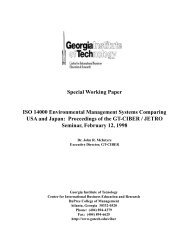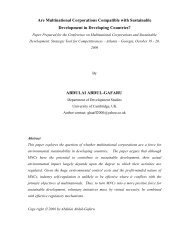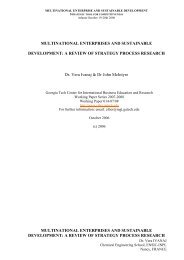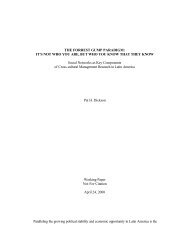AMD vs Intel: Technology, Competition, and Sustainability
AMD vs Intel: Technology, Competition, and Sustainability
AMD vs Intel: Technology, Competition, and Sustainability
You also want an ePaper? Increase the reach of your titles
YUMPU automatically turns print PDFs into web optimized ePapers that Google loves.
<strong>AMD</strong> <strong>vs</strong> <strong>Intel</strong>: <strong>Technology</strong>, <strong>Competition</strong>, <strong>and</strong> <strong>Sustainability</strong><br />
Hugh Folk 1<br />
<strong>Technology</strong><br />
Computers will influence everything that is do in the future. Now they store,<br />
process, <strong>and</strong> communicate all of the information of politics, business, education,<br />
medicine, literature, music, telephone calls, science, <strong>and</strong> technology. They are our<br />
companions <strong>and</strong> our teachers. They are our untiring associates in research, invention, <strong>and</strong><br />
discovery. Just to prove that they are only human, they sometimes err.<br />
Computers are largely composed of microprocessors <strong>and</strong> memory chips which are<br />
integrated circuits containing millions, sometimes billions of transistors <strong>and</strong> are made<br />
largely of silicon, one of the most plentiful atoms in the earth’s crust. The complexity or<br />
number of transistors of the average integrated circuit increases by about 58 percent a<br />
year. Average productivity (output per man hour) in the semiconductor industry<br />
increases by about 27 percent a year. Microprocessors are the part of the computer that<br />
performs the mathematical <strong>and</strong> logical operations referred to as computing. The speed<br />
<strong>and</strong> power of a particular state-of-the-art microprocessor design (an <strong>AMD</strong> Athlon or an<br />
<strong>Intel</strong> Core 2 Duo) depend on the architecture, or design, of the number <strong>and</strong> size of the<br />
billions of transistors to be incorporated into each of the several hundred identical dies, or<br />
slivers of processed silicon, on the thin, round 300 mm wafer of silicon <strong>and</strong> the<br />
conductivity of the lines, or narrow, flat, thin copper wires that will interconnect the<br />
transistors. Each design is put together by experts using specialized computer programs<br />
which combine new or previously used modules to make the patterns for masks through<br />
which extreme lasers project high frequency 248 or 193 nm ultraviolet light which forms<br />
tiny interference patterns on the processed silicon wafers which solubilize the<br />
photoresistant compound previously spun on the wafer. A hundred or more similar steps,<br />
each requiring specialized equipment <strong>and</strong> reagents arranged in separate work stations to<br />
etch channels, deposit metal interconnects <strong>and</strong> silicon dioxide insulating layers, or<br />
connect the several layers that make up the chip. Each work station will have automated<br />
wafer manipulation equipment to remove each partially processed wafer from a multiwafer<br />
carrier or cassette, <strong>and</strong> insert each wafer into a dust free vacuum reaction chamber<br />
where it is processed. Each reaction chamber utilizes a unique, corrosive, toxic chemical<br />
or high-termperature vaporized metal generated on site or pipelined through the dust-free<br />
“clean room” where the processing stations are located. At any step, a single grain of dust<br />
can destroy a die that if completed would sell for several hundred dollars. 2<br />
1 Professor of Management, Shidler College of Business, University of Hawaii at Manoa, folk@hawaii.edu.<br />
2 Fab cost accounting is very strange. Yield, or average percentage of good chips from a wafer, is said to be<br />
critical to economic success, but the market price of the chip itself if only a few dollars per square<br />
centimeter of silicon. That is to say, variables costs are quite low. The fixed cost of the completed design<br />
<strong>and</strong> the fixed cost (in the billions) of an up-to-date fab <strong>and</strong> the 60 percent gross margin set the multihundred<br />
dollar price of the microprocessor chip. Design <strong>and</strong> fab costs are sunk <strong>and</strong> must be recovered for<br />
2















